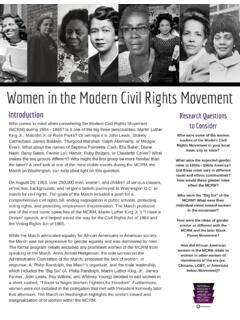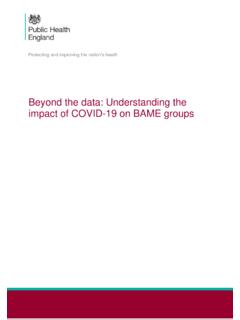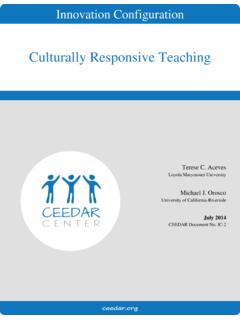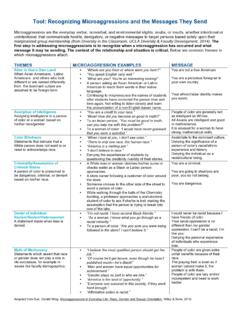Transcription of This hand-out is from the Racial Healing Handbook ...
1 This hand-out is from the Racial Healing Handbook : Practical Activities to Help You Challenge Privilege, Confront Systemic racism , and Engage in Collective Healing by Anneliese A. Singh, PhD, LPC. WHAT DOES IT MEAN TO BE ANTIRACIST? The term antiracist refers to people who are actively seeking not only to raise their consciousness about race and racism , but also to take action when they see Racial power inequities in everyday life. Being an antiracist is much different from just being nonracist, as Black antiracist Marlon James (2016). made clear. Being a nonracist means you can have beliefs against racism , but when it comes to events like the murders of Black men by police, you can watch things at home unfolding on TV, but not do a thing about it. According to James, being an antiracist means that you are developing a different moral code, one that pairs a commitment to not being racist (whether verbalized or not) with action to protest and end the racist things you see in the world.
2 I would add that saying you aren't a racist isn't enough to start Healing from racism . You need the intentional mindset of Yep, this racism thing is everyone's problem including mine, and I'm going to do something about it. Of course, being an antiracist is a different proposition for a person of color than it is for a White person. Let's examine what an antiracist identity looks like on both sides of this binary. Becoming an Antiracist as a White Person For White people, becoming an antiracist is a journey that evolves alongside your White Racial identity. For instance, once you have moved out of obliviousness about your White privilege, you can move toward integrative awareness of what it means to be White and how to use your White privilege. The stages of using your White privilege to change your internalized racism and to interrupt racism when you see it are a big part of developing an antiracist identity.
3 In her article White Supremacy Culture: Changework, Tema Okun (2006, 13) talked about antiracism based on her own journey as a White person taking on this identity. I slightly adapted her list of ways to be a White antiracist: See yourself as part of the White group. Understand and begin to take responsibility for your power and privilege as part of the white group such as acknowledging the historical roots of White Supremacy and knowing that the White privilege you have as a result of that history is a real thing. Have all the feelings related to deepening relationships and increased multicultural experience both the feelings of guilt, anger, or frustration that can sometimes arise in a racist system in which you experience privilege and the feelings of joy and connection to others that will emerge from pursuing diverse relationships and acting to protest and combat racism you encounter.
4 Distinguish between your commitment to being a White antiracist and the part of you that wants to be a perfect antiracist socialization is real, and racism is real, and you won't always be perfectly antiracist. Know there will be hard things that come up when you explore White privilege. Learn to see these challenges as teachers and opportunities to learn more about your own Whiteness. Instead of getting defensive when these challenges arise, lean into curiosity and cultivate desire for understanding and growth. Participate in individual and collective action against racism . Value self-reflection on your White identity. Use racist thoughts and behaviors you might engage in to deepen understanding and continue to change thoughts and behaviors. Okun believes that White folks can take on six specific responsibilities to become antiracist in an ongoing process.
5 Being an antiracist is not a one-time event or decision, or an identity you ever finally and fully achieve, but a commitment. Her six responsibilities will remind you of our earlier discussion of raising your race-consciousness through education and people resources. Below are Okun (2006)'s six Rs: 1. Read and educate yourself on the effects, impacts, and other structures of racism . 2. Reflect on what this education means for you as someone developing a White antiracist identity, such as identifying new ways to challenge everyday racism and work on Racial justice initiatives. 3. Remember how you participate in the thoughts, beliefs, and actions that uphold racism , whether you intend to or not, and how you forget that racism exists. Identify internalized Racial attitudes you have about people of color. 4. Take risks to challenge racism when you see it or realize when you are participating in it.
6 Interrupt Racial stereotypes when you hear them, and support people of color in your personal and professional settings when they speak out about their experiences with racism . 5. Rejection is something you'll experience as an antiracist, as sometimes you will make mistakes and get it wrong when it comes to identifying and challenging racism . Because of your White privilege, it will sometimes be tough to identify how something you are doing may be harmful to people of color. And people of color may reject what you are saying and even more so hold you accountable for these missteps. Learn to understand and accept rejection. People of color have justified anger about racism , and they may reject you or White people harshly because of it. If this happens, understand that this is the product of their treatment at the hands of a racist system.
7 Don't take it personally; rather, help them if you can and continue to stay in the fight against racism . 6. Relationship building is a part of what you do along the way with White folks and people of color who are somewhere on their journey from nonracist to antiracist. Let's look at an example of what becoming a White antiracist using these six Rs looks like in the real world. Michael, a White, twenty-year-old college student, grew up in a homogenously White family and neighborhood and attended predominantly White schools. He moved to a racially diverse area for the first time when he went to college and had a roommate who was a person of color. Michael realized that people around him had experiences he didn't know much about, and that he himself could be behaving in ways that disrespected people of color in ways he might not even be realizing.
8 Michael decided to take a college course on diversity in his first year and began working on learning more about his White privilege and how to become an antiracist. We can look at the steps he took in terms of Okun's six Rs: 1. Michael read and educated himself on what White privilege was. He considered the effects it had on his own life in terms of lost opportunities to interact with people of color and learn a more truthful history of the world as it related to race and racism , and what it meant for people of color to lack such privilege. As he read and educated himself, he learned about the impacts of racism on other Racial groups and how structures of racism are upheld in current times. 2. Michael began to reflect on what this education meant for him. He wanted to cast aside the obliviousness he had about racism and White privilege.
9 He knew that being an antiracist would mean identifying ways he had previously ignored everyday racism that people of color experienced ( , he remembered the one Latinx student in his middle school class being called Racial epithets and not realizing how these were racist acts) and Racial microaggressions he had enacted ( , assuming Asian Americans were recent immigrants). He joined an antiracist campus group, where he and other folks with White privilege could interrupt everyday racism and work on larger campus Racial justice initiatives. 3. Michael made sure to remember throughout his antiracist work that he would inevitably forget about racism and its systems because that is how racism works. He kept educating himself on the different ways White privilege can show up ( , feeling guilty about racism , not having to think about race, not being extraordinarily worried when pulled over by police for a traffic ticket, not knowing the history of the land his campus was on and who the indigenous peoples were).
10 He also intentionally explored negative Racial stereotypes he still held about people of color and sought to expand the diversity of people in his life. 4. Michael took risks to challenge racism when he saw it in his classes, like when his professors wouldn't call on his fellow students of color. He also assumed a leadership role in his residence hall, and he challenged his fellow White student leaders to think about how their Racial privilege influenced selection of programming for their dorm. 5. Michel knew to expect rejection from people of color when he made a racist assumption or was misusing his White privilege. For instance, sometimes he was so excited about his efforts to be an antiracist, he would talk over people of color doing similar work and minimize their contributions. He learned to apologize as soon as he noticed this was happening or when a person of color brought this to his attention.






